
Anglers keep a sharp lookout for red drum in shallow waters each November.
Having the eyesight of an eagle isn’t required to be a successful red drum fisherman, but it certainly helps.
In fact it helps most of the time.
Many successful anglers point to sight as the primary means of locating redfish, especially when they’re moving slowly and not really in a feeding mood. Certainly it’s good to know a school of fish is almost always at a certain flat at low tide every day. But being able to see exactly where they are allows setting up on them and fishing, rather than taking a chance on spooking them by moving to where you think they are.
Most anglers can spot the big swirls of a school of feeding fish or the sudden pushes when a school of reds is spooked. But the ability to see one barely-moving fish, stalking its dinner through broken grass, is something that only can be learned to a certain point.
To borrow from a popular basketball recruiting axiom, “You can’t coach tall.”
Superior vision is the same; anglers can learn the signs, but if their vision isn’t top notch and they aren’t in a position to use it, they’re operating with a handicap.
Capt. Noah Lynk of Noah’s Ark Charters (www.noahsarkfishingcharters.com, 252-342-6911) said sight is so essential to consistently finding puppy drum he designed a special mini-tower for his Bay Rider skiff. The tower is a lookout above his T-top that allows him 8 extra feet of elevation above the deck. In addition, the tower, made by Hancock Grandsons at Harkers Island Road, pivots down to T-top height to allow access under low bridges at the Harkers Island area.
Bob Chew, former president of Seaswirl Boats, designed for extra height in another way. At his direction, Seaswirl added a sighting console option to the Striper line of Seaswirl bay boats.
It’s a step-up console with a retracting support bar that also acts as the console rail when in the down position. Anglers may raise the support bar and stand on top of the console for 45 inches greater height than the deck and enjoy superior visibility.
“The extra sight range is an incredible difference in locating fish,” Chew said. “It also helps keep your decks clear and eliminates the need for a poling platform as a sighting aid. You can lower the rail to 6 inches above the console and easily get under most bridges or store the boat in a regular garage or carport.”
“The difference in what you can see from the deck and the tower is so great it’s hard to appreciate unless you see it for yourself,” Lynk said. “On a calm morning, I can see the wake of a single moving fish farther than most folks can see. Spotting bait is also extremely easy. Sometimes when a creek really winds around, I can be in one section and look across the marsh grass into another section.
“When I see fish, I know to go into stealth mode and creep up on them before I get anywhere near close enough to spook them. Sometimes, when the bottom is firm enough and my customers are willing, we get out of the boat and wade or walk through the marsh to get to them rather than risk spooking them with the boat.
“The extra height also allows me to see sand bars and oyster rocks. In addition to helping find fish, it allows me to locate the deeper water and work my way through shallow areas.”
Lynk also uses his tower to spot redfish feeding in the surf and just beyond while fishing at Shackleford Banks each fall. He said the wind is often just right to drift down the beach, so he positions the boat just outside the breakers and climbs into the tower. He said sometimes he carries a rod and reel into the tower to be able to cast to areas that have a red tint, which usually signifies redfish.
“Surf fishermen can also use height to help them find drum,” Lynk said. “In areas where they can drive on the beach, they can stop occasionally and climb up on their trucks for added height.
“We often anchor the boat behind Shackleford (Banks) and hike across to fish. When we do this, we pause on the high parts of the dune before walking down onto the beach and take a good look up and down the beach. Sometimes, especially if there is a good school of drum in one of the sloughs, you can see the red color in the water and know exactly where to fish. At worst, you can spot the sloughs and know where the most likely spots will be.”
Lynk fishes the inside waters with a couple of simple rigs and a variety of baits. He likes live baits and uses shrimp, mullet minnows, tiger minnows and mud minnows. For artificial lures, he likes scented soft baits, including Fishbites Xtreme Scent Release Baits, Bass Assassin/Saltwater Assassin Blurps and Berkley Gulps. He prefers shrimp shapes and said the Fishbites Xtreme Scent Release shrimp in the white color is his favorite.
“Because of the many oyster rocks in the area I fish, I use a lot of (lures) under floats to keep from getting hung up,” Lynk said. “I like the reaction strikes drum make on topwater lures, but not everyone can work a Zara Spook or Skitterwalk, so I approach it a little more simply. I use oval Cajun Thunder rattling corks with the brass beads.
“My fishermen can jerk the cork every few seconds and get a similar effect as a topwater lure but not have to learn how to walk the dog. In addition to the splash when they jerk the Cajun Thunder, the brass beads also make a noticeable click, which helps attract fish. This corks works well with live (baits) and artificial (lures).”
When flounder fishing or when a bottom rig is needed, Lynk uses a rig of his own design. He ties about 4 feet of 20- or 25-pound test clear monofilament leader to the line from his reel, then slides an egg sinker (the lightest that will hold bottom) up the leader and ties a hook at the end (he doesn’t use a swivel). Then Lynk doubles the leader through the egg sinker and ties a single overhand knot in it to create enough tension to hold the sinker in place, yet allows moving the sinker to lengthen or shorten the distance between the hook and sinker. The hook is a 1/0 or 2/0 Owner or Gamakatsu octopus hook and is tied on with a loop. Lynk uses live baits and soft-plastic (lures) with this rig.
While ocean fishing, Lynk primarily uses artificial baits. He prefers the Calcutta Flash Foil Swim Shad in 3- and 4-inch lengths and 1/2- and 7/8-ounce weights and Storm Wildeye Swim Shads in 4-, 5- and 6-inch lengths and 7/16-, 5/8- and 7/8-ounce weights.
“I’m usually fishing the surf zone in the ocean,” Lynk said. “We might be in the boat casting in or on the beach casting out. Either way, the heavier baits help us cast farther, plus they also stabilize the bait in the rough water.”
Lynk said the biggest key to catching red drum in the fall is locating fish. Reds must add weight for the winter, and that hard-wired urge turns them into eating machines during November. They’ll hit a variety of baits or lures.
Once they gather in schools they often give the water a red tint, and the ability to see that red luminosity from a few feet above the water puts the odds in favor of anglers.

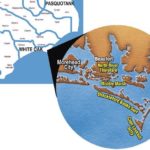
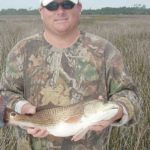
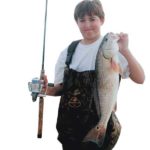

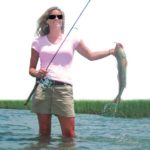
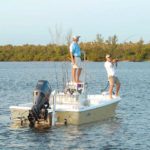
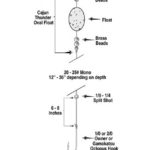
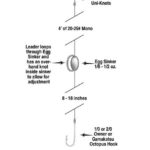
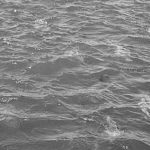

Be the first to comment